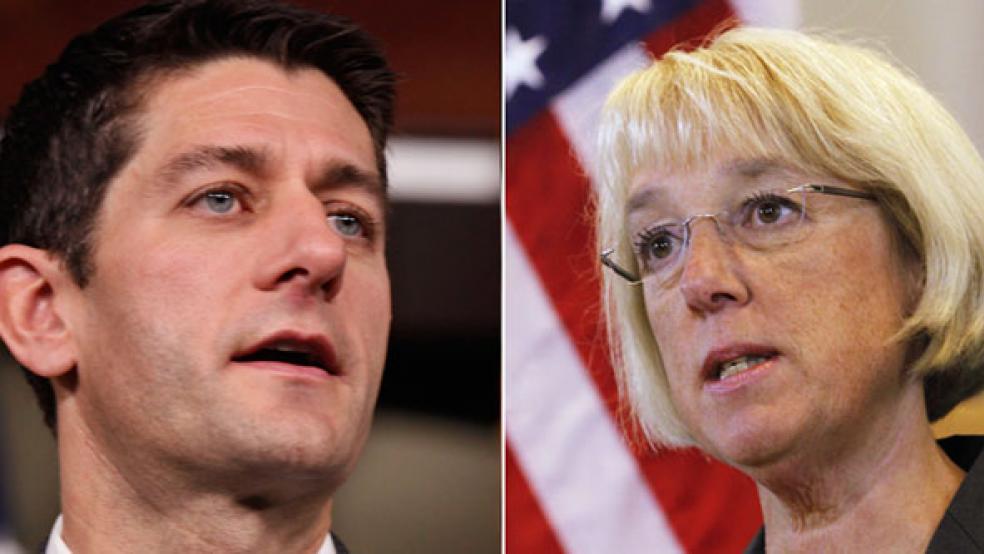The private and painstaking talks between Democratic Sen. Patty Murray and House Republican Paul Ryan are coming to a head, as the two sides press to craft a new budget plan to meet a Dec. 13 deadline. If they fail, the federal government will face a second round of automatic spending cuts and yet another possibility of a shutdown early next year.
The two sides long ago abandoned any hopes for a “Grand Bargain” of sweeping entitlement and tax reforms to address the nation’s long term debt and fiscal problems while authorizing more immediate measures to spur a lagging economic recovery.
Related: The Shocking Cost to Taxpayers of a Government Shutdown
Exhausted by a year of relentless partisan sniping over the budget and debt ceiling that culminated in a 16-day government shutdown in October, Senate Democrats and House Republicans are searching for a minimalist plan that protects their most cherished priorities while still being able to pass muster with both parties.
If they can’t cut a deal, the House, Senate and President Obama will find themselves back in crisis mode in early January, with only a week or so to hammer out an emergency measure to prevent another shutdown.
The biggest question hanging over the negotiations is whether Congress will block a second round of automatic spending cuts under the 2011 Budget Control Act or allow the sequester to continue.
The sequester was designed to achieve $1.2 trillion of savings over the coming decade absent congressional intervention. But with so many complaints from the Pentagon and federal agencies about the hardships being caused by the across the board cuts, Congress has been under pressure to do something about it.
The Senate is pressing to replace the sequester with a package of alternative spending cuts, tax loophole closings to raise almost $1 trillion in new revenue over 10 years, and some reforms of Medicare and other entitlement programs. The House, meanwhile, insists on authorizing $91 billion less in domestic spending in the coming year than the Senate favors and it unalterably opposes raising tax revenues for more spending.
Related: GOP Budget Strategy Takes Obamacare off the Table
"If we focused on doing some big grand bargain, like those prior efforts ... then I don't think we'll be successful because we'll focus on our differences,” Ryan, the House Budget Committee Chairman from Wisconsin, told Reuters earlier this fall. “Each party will demand that the other compromises a core principle and then we'll get nothing done."
Murray, the Senate Budget Committee chairwoman from Washington State, has been consistently more upbeat and optimistic than Ryan since the two began presiding over a bipartisan House-Senate budget conference committee and meeting privately.
“She is encouraged that the talks continue and hopeful that they continue to make progress to get to a deal,” Eli Zupnick, Murray’s chief spokesman, said this week.
How the Government Shutdown Shook Up the U.S. Economy
The private talks and a series of tangential public hearings held by the committee have lacked the drama and suspense of previous negotiations going back to the budget and debt ceiling crisis of 2011, which led to the passage of the Budget Control Act and imposition of the sequester. With public approval of President Obama and Congress at record lows, neither party can afford another budget crisis or threat of default on the U.S. debt heading into the 2014 mid-term elections.
What’s more, while Democrats are eager to spare the president’s domestic agenda from additional automatic cuts, many Republicans are comfortable with the current budgetary status quo, even if it’s far from their ideal.
The automatic sequestration cuts locked in deficit savings, while the fiscal cliff deal at the start of this year locks in tax rates, so it takes a legislative change to increase revenues.
Neither party was happy with the $85 billion worth of automatic cuts in domestic and defense program this year, under the sequester. The next round of cuts will be even larger, in the range of $109 billion, throughout the fiscal year that runs through next Sept. 30.
A growing chorus of Republican defense hawks is particularly concerned that a second round of sequester cuts to the Pentagon budget would hollow out the nation’s armed forces.
Related: How a Leaner Military Could Save U.S. Defense
In an Oct. 23 letter to Ryan and Murray, Republican members of the House Armed Services Committee warned, “Continued sequester would lead to the reduction of an additional 100,000 soldiers, sailors, marines and airmen from our Armed Forces, and cancellation of important programs providing key technologies and capabilities.”
Democrats are counting on this mounting GOP concern about defense to force Ryan into a compromise that would give them additional domestic funding and tax revenues. But several Republicans on the budget conference committee -- including Sen. Chuck Grassley (R-IA) -- have suggested that another round of automatic cuts in defense is preferable to taking a bad deal.
“Obviously, [Ryan] would like to change the sequester to protect defense, but I think he has made it pretty clear in the past that if agreement cannot happen, we’re not just going to just walk away from sequester,” said a House GOP staffer.” We fought for those spending cuts back in 2011, we’re proud of them, and we’re not just going to give them up. . . .I think at the end of the day, we’re going to have a sequester if agreement is not reached.”
Top Stories from The Fiscal Times:





